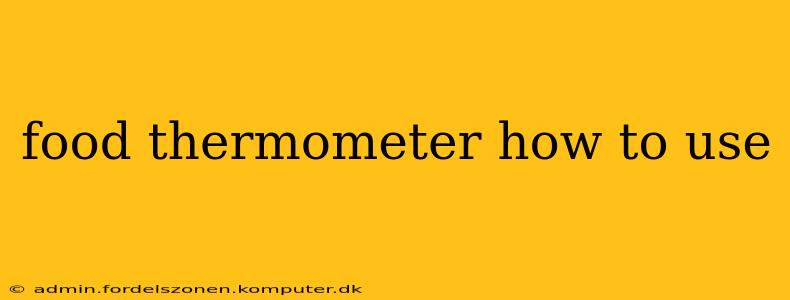Food thermometers are essential tools for ensuring food safety and achieving perfectly cooked meals. Whether you're grilling steaks, baking cakes, or frying chicken, a reliable thermometer guarantees that your food reaches the correct internal temperature, eliminating the guesswork and preventing foodborne illnesses. This comprehensive guide will cover everything you need to know about using a food thermometer effectively.
What Types of Food Thermometers Are There?
Several types of food thermometers are available, each with its own advantages and disadvantages:
-
Instant-read thermometers: These are the most common type, offering quick temperature readings. They're ideal for checking the temperature of meat, poultry, and other foods during cooking. They are generally inexpensive and easy to clean.
-
Leave-in thermometers: These thermometers are inserted into the food before cooking and remain in place throughout the cooking process. They provide continuous temperature monitoring, ideal for roasting larger cuts of meat or baking.
-
Oven thermometers: These thermometers are placed inside your oven to ensure it’s reaching the temperature indicated on the dial. Accurate oven temperature is crucial for consistent baking results.
-
Infrared thermometers (non-contact): These thermometers measure surface temperature without touching the food. They are useful for quickly checking the temperature of grills, ovens, and even the surface temperature of food. However, they don't provide internal temperature readings.
How to Use an Instant-Read Thermometer: A Step-by-Step Guide
-
Calibrate your thermometer: Before each use, check the accuracy of your thermometer. Many instant-read thermometers have a calibration feature. Refer to your thermometer's instruction manual for specific calibration steps.
-
Insert correctly: Insert the probe into the thickest part of the food, avoiding bone or fat. For poultry, insert the probe into the deepest part of the thigh. For ground meats, check multiple locations to ensure even cooking.
-
Wait for the reading: Hold the thermometer still until the reading stabilizes. This usually takes only a few seconds.
-
Clean thoroughly: Wash the probe with hot, soapy water after each use.
What Temperature Should My Food Be Cooked To?
The Food and Drug Administration (FDA) recommends the following minimum internal temperatures:
- Ground meats: 160°F (71°C)
- Poultry (whole or ground): 165°F (74°C)
- Beef, pork, lamb, and veal (steaks, roasts, chops): 145°F (63°C)
- Fish: 145°F (63°C)
How to Use a Leave-in Thermometer
Leave-in thermometers offer a hands-off approach to temperature monitoring. Simply insert the probe into the food before cooking, ensuring it's in the thickest part, away from bone and fat. Then, place the food in the oven or on the grill and monitor the temperature throughout the cooking process. The thermometer will alert you when the desired temperature is reached.
How Often Should I Check the Temperature?
The frequency of temperature checks depends on the food and the cooking method. For large roasts, you may only need to check the temperature once or twice during cooking. However, for smaller cuts of meat or when using faster cooking methods like grilling or pan-frying, it's crucial to check the temperature more frequently.
What are the safety precautions when using a food thermometer?
- Always wash your hands thoroughly before and after handling raw meat.
- Never use the same thermometer for raw and cooked foods without thoroughly washing and sanitizing it between uses. A dedicated thermometer for raw meats is highly recommended.
- Handle the thermometer with care to prevent damage to the probe.
- Always refer to your thermometer’s instructions for specific operating and cleaning procedures.
Why is using a food thermometer important?
Using a food thermometer is crucial for several reasons:
- Food safety: It helps to prevent foodborne illnesses caused by undercooked food.
- Consistent results: It ensures your food is cooked to the perfect level of doneness, every time.
- Reduced waste: By cooking food to the correct temperature, you reduce the risk of overcooking and wasting food.
By following these guidelines, you can confidently use a food thermometer to ensure food safety and delicious results every time. Remember, a food thermometer is an investment in your health and culinary success.
